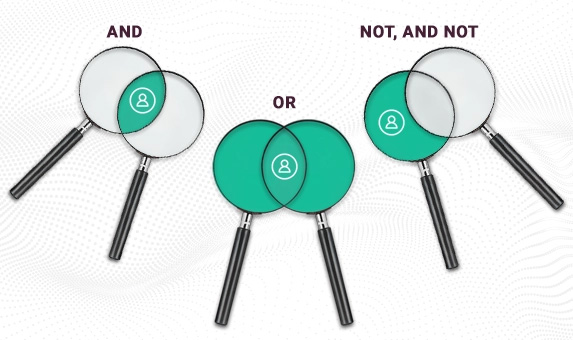Boolean Search Recruiting In The Era of ChatGPT

In today’s digital age, sourcing great candidates is half the battle of recruiting. In order to hire the best person for the job, recruiters must identify, interview and pique the interest of the right people. Reason why recruiters around the globe are constantly seeking ways to streamline their hiring process and find the most perfect candidates for open positions. One such powerful tool is using Boolean Search queries with ChatGPT.
What is Boolean Search?
Boolean search is a query methodology that is used to broaden, narrow or refine search results. Named after and invented by George Boole, an English mathematician and author of The Mathematical Analysis of Logic (1847), it has significantly influenced the evolution of the search-engine giant, Google. Boolean Search is a structured search process that allows the user to insert words or phrases such as AND, OR, NOT to limit, broaden and define the search results. Boolean search allows the combination of five different elements to conduct a search and utilizes a search engine to its fullest potential.
In recruitment, Boolean search helps to quickly and effectively locate ideal candidates for open roles. Similar to an “Advanced Search” function, Boolean search operators — words and symbols — allow you to include, exclude and tag specific keywords to carefully refine your search results. Ultimately, the goal of using Boolean search in recruitment is to hone in on broad topics — such as job titles or requirements — to identify a desirable, niche candidate pool.
Understanding Boolean Search Queries/ Operators
As mentioned above briefly, Boolean search queries are combinations of keywords and operators that allow users to define specific search criteria. By using operators such as “AND,” “OR,” and “NOT,” recruiters can narrow down or broaden their search parameters to find the best candidates. Here’s a breakdown of the commonly used Boolean operators:
AND
The operator “AND” helps you broaden your search by adding multiple keywords to your search. For example, you can use this operator when looking for a content writer and creator. The search string would look like this: content writer AND creator
This operator does not need to be specified when searching on Google and LinkedIn, or even on your regular job posting sites. The space works as the AND operator. Simply typing “content writer-creator” will give you the results you are looking for.
OR
When you want to specify alternatives for the role or skill you are looking for, use the OR search string. For example, you could be looking for a content writer or creator or developer. In that case, your search query would look like content AND writer OR creator OR developer This operator can also be used to identify candidates who spell certain words differently. For example graphic design AND Adobe AND Photoshop OR Photo shop AND Lightroom OR Light Room On Google, LinkedIn, Monster, and Bing, use the pipe character (|) instead of OR for more accurate results.
NOT or – (the hyphen)
The NOT operator is a great tool to limit your search to specific terms. For instance, if you want to look for a content writer/creator specifically but not an editor, then the results that show up will exclude the term “editor” from the search. Your search query will look like this: content AND writer OR creator NOT editor On Google and LinkedIn, use the hyphen instead of the word NOT. content writer OR creator -editor
Brackets ()
Brackets maintain groupings and indicate priority. Let’s say we’re looking for either a software engineer or developer. Since engineers specialize in various disciplines — chemical, mechanical, biomechanical, etc. — and developers are often associated with construction, it’s important we include software in our search string.
Without the brackets operator, the search string would look like this: software AND engineer OR developer NOT jobs. In this example, the search engine does not know which search to prioritize. Including brackets around engineer OR developer signals to the search engine to perform the engineer OR developer query first, then eliminate all results that do not include “software,” and all results relating to job, jobs, hire or hiring.
Quotations “”
Probably the search operators’ most familiar tool. Recruiters often use it when we’ve lost track of the source for a quote we like or when we need to find the name of a song we only remember a line or two of.
However, when performing a Boolean search in recruitment, only use the quotations operator when you are confident in the exact phrase you’re looking for. Otherwise, you’ll unintentionally exclude a large pool of viable results.
Constructing Effective Boolean Search Queries
To construct effective Boolean search queries, recruiters need to identify key criteria and carefully combine operators. Below are some strategies one may consider:
Specify Job Titles and Skills
Begin your query by listing the desired job titles and the essential skills required for the position. For example, “Software Engineer AND (Java OR Python)” would return candidates who are skilled in either Java or Python programming languages.
Include Synonyms
To broaden your search, include synonyms or related terms for the desired skills or job titles. For instance, “(Marketing OR Advertising OR Promotion) AND (Manager OR Director)” would return candidates with experience in any of the mentioned marketing-related roles.
Consider Location
If the position requires candidates to be geographically close to the workplace, include location parameters in your search query. For example, “Sales Representative AND New York” would narrow down the search to candidates located in New York.
Exclude Unwanted Criteria
To refine your search, use the NOT operator to exclude criteria that are not relevant. For instance, “Mechanical Engineer AND (NOT Senior)” would exclude candidates with senior-level experience from the results.
Use Parentheses
Parentheses can help structure complex search queries and group related criteria. For example, “Graphic Designer AND (Adobe OR Photoshop) AND (NOT Freelance)” would narrow down the search to graphic designers with expertise in Adobe or Photoshop, excluding freelancers.
Leveraging ChatGPT for Recruiting
ChatGPT can enhance the effectiveness of Boolean search queries by offering real-time assistance and refining search criteria. Here’s how recruiters can leverage ChatGPT in order to find the most suitable candidates for their open positions:
Real-time Query Suggestions
As you construct your Boolean search query, ChatGPT can provide real-time suggestions based on the keywords and operators you’ve entered. These suggestions can help refine and optimize your query, ensuring more accurate results.
Natural Language Query Processing
ChatGPT’s advanced natural language processing capabilities enable recruiters to input queries in conversational language. Recruiters can phrase their queries as if they were having a conversation, making the process more intuitive and efficient.
Contextual Clarification
In cases where the search query is ambiguous or unclear, ChatGPT can seek clarification and provide suggestions to refine the query. This ensures that recruiters receive the most relevant results.
Iterative Query Refinement
Recruiters can collaborate with ChatGPT to iteratively refine their search queries. The model can understand and incorporate feedback, enabling recruiters to progressively improve the search parameters for better candidate matches.
Conclusion
Constructing effective Boolean search queries is crucial for recruiters seeking to optimize their hiring process. By leveraging the power of ChatGPT, recruiters can enhance their search efforts and identify the most suitable candidates. With a solid understanding of Boolean operators and a strategic approach to constructing queries, recruiters can save time, streamline the search process, and ultimately find the perfect candidates for their open positions. So, take advantage of ChatGPT’s capabilities, follow the strategies outlined in this blog post, and embark on a more efficient and successful recruiting journey.
FAQs
What is Boolean search and how does it impact recruiting?
Boolean search is a structured search process that utilizes operators like AND, OR, and NOT to narrow down or broaden search results. In recruiting, it helps quickly locate ideal candidates for open roles by refining search parameters and identifying niche candidate pools.
How do I use Boolean search operators in recruitment?
Boolean search operators like AND, OR, NOT, parentheses, and quotations can be used to construct effective search queries. They allow recruiters to combine keywords and refine search criteria to find the best candidates for specific roles.
Can I use Boolean search operators on popular job posting sites and search engines?
Yes, popular platforms like Google, LinkedIn, Monster, and Bing support Boolean search operators. By using these operators, you can enhance your search accuracy and find candidates who meet specific criteria.
How can ChatGPT assist in optimizing Boolean search queries?
ChatGPT offers real-time query suggestions, natural language query processing, contextual clarification, and iterative query refinement. It helps recruiters refine and optimize their search queries, ensuring more accurate and relevant results.
What are some strategies for constructing effective Boolean search queries?
Recruiters can specify job titles and skills, include synonyms, consider location parameters, exclude unwanted criteria using NOT, and use parentheses to structure complex queries. These strategies help recruiters find the most suitable candidates for their open positions efficiently.
References
- https://builtin.com/recruiting/boolean-search-in-recruitment
- https://www.spiceworks.com/hr/recruitment-onboarding/articles/what-is-boolean-search-in-recruiting-process-with-examples-for-google-and-linkedin/





